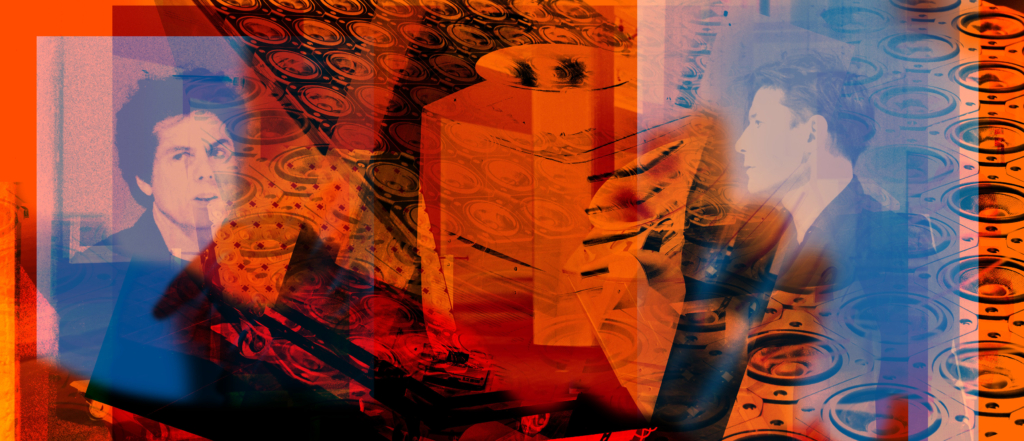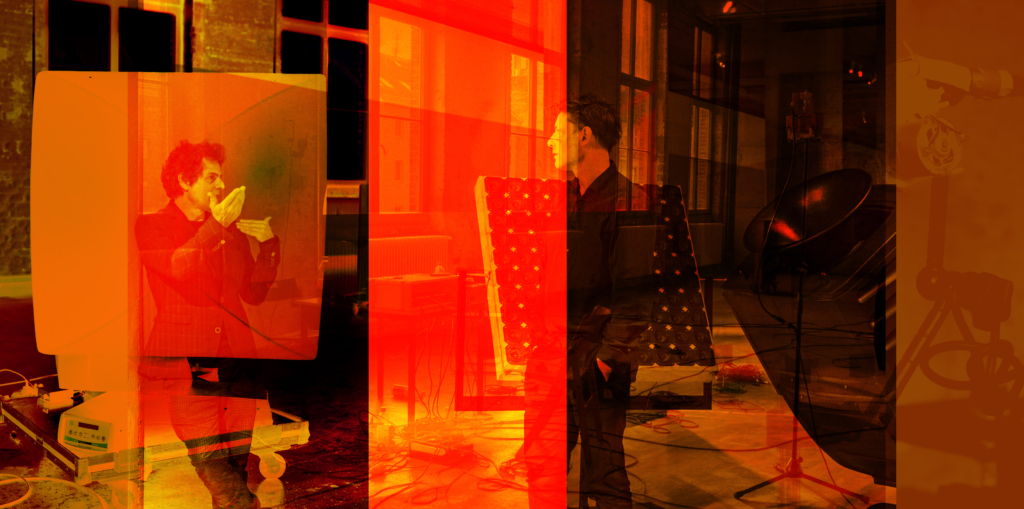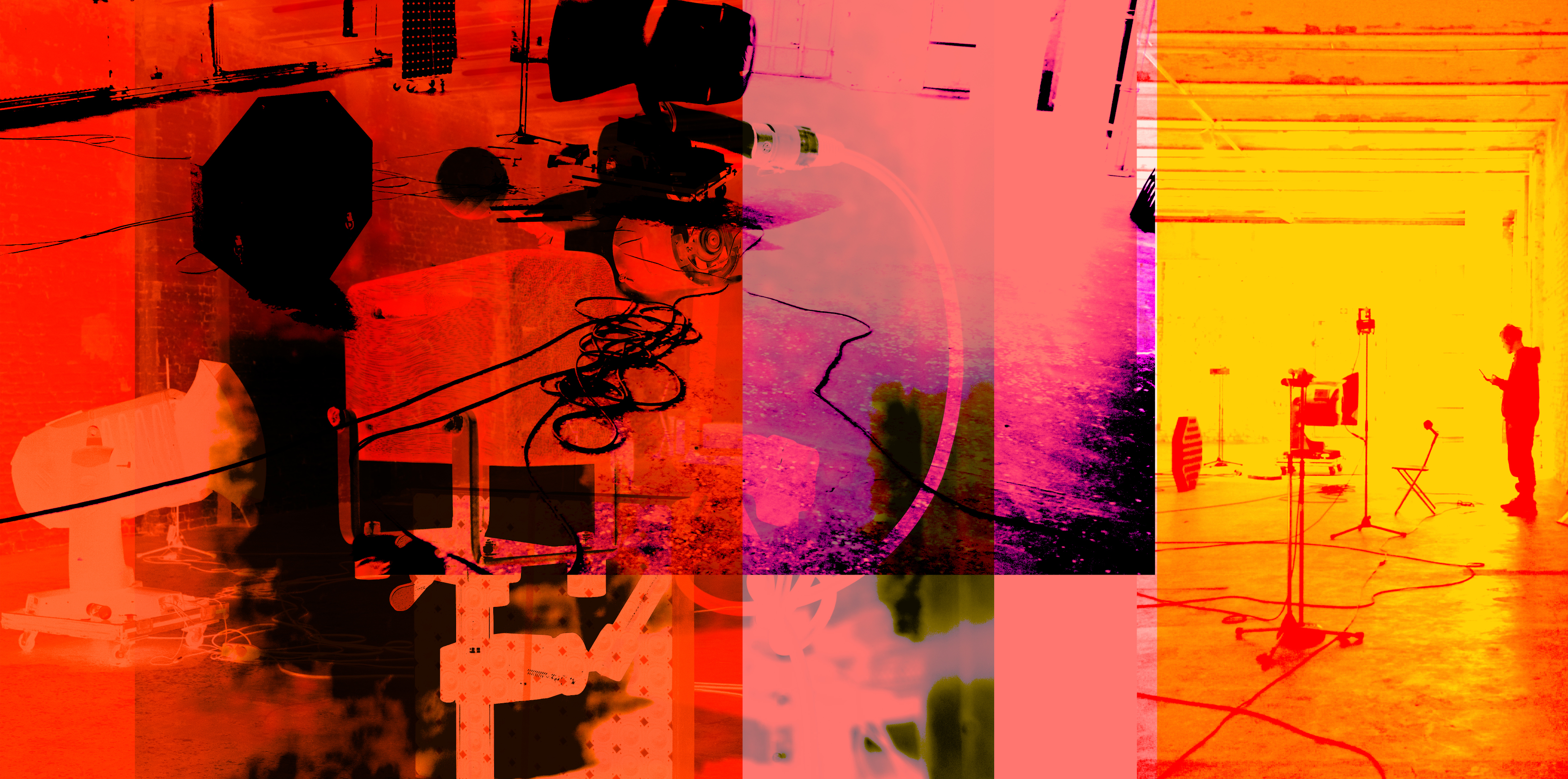In anticipation of the German electronic duo Mouse on Mars’ new installation at Lenbachhaus in Munich, we spoke to co-founder Jan St. Werner to learn more about the exhibition, the group’s interest in spatializing music, and his ideas around the power of sound.
“If we cracked the code, we would probably stop working.” With over 30 years of professional musical experience and a 28-year discography under their belt, the German electronic duo Mouse on Mars is an acoustic machine fueled by a motor of enduring curiosity. Founded by long-time friends Jan St. Werner and Andi Toma, Mouse on Mars is accredited as one of Germany’s most iconic electronic music projects. The band’s work is distinguished by rigorous sound research, technological innovation, and dialectic exchange and experimentation. Change, for this duo, is the only constant.
Mouse on Mars’ current acoustic research is focused on spatializing sound and breaking away from the dominant, stereo-centric mode of understanding and interacting with amplified noise. Spatial Jitter, a dynamic sound and light installation held at the Lenbachhaus museum in Munich, is the duo’s largest effort into this field of research so far, marking “both a completion of a chapter and a beginning of a new one.” To learn more about the vision behind the installation, as well as about the group’s work and future endeavors, we spoke to co-founder Jan for FF Mixtape Feature #175, who also shared the group’s tracks for “introspective space construction.”
You can catch the exhibition at the Lenbachhaus in Munich, running from April 9 – September 18, 2022. Special performances and accompanying programs can be found here.

-
What is the story behind the exhibition “Spatial Jitter”?
We wanted to liberate all of the elements and robotic systems that are usually in the background of a performance, concert, or rehearsal space, and synchronize them with light and sound. We are trying to reveal existing, beautiful circuits and cyber-sonic escapades that are not visible when we perform as a band.
Another major concern for us is spatializing music. We want to break away from this idea of stereoizing sound, which is the dominant way we understand amplified music: You mix things for two earphones or with two loudspeakers, and you perform on stage between two big PA Arrays. But we have always viewed music as a landscape or setting that you could set a stage within; a layering of situations, densities, and approximations. For us, sound has always been a more abstract but also a more vivid and lively idea that is not clearly represented in stereo mixes.
Jitter is also a term from granular synthesis. You would use it to juggle the smallest detail of a sound, producing a random pattern or complex algorithm of positions and movement. We wanted to translate this idea into a real space so that people could experience these dimensions and architecture of sound.
It is a liberating project for us as well because we are not performing. We can enjoy it, and we can walk around, listen, and be our own audience. We have heard it a million times by now, and we keep discovering things.

-
Describe the ways in which light, sound, and space interplay in the installation.
The installation plays with different artifacts and psycho-acoustic effects, and tries to engage your acoustic and visual perception along with your other senses. There are artifacts which appear in certain areas of the space, as well as a sub-layering of frequencies, which create pulses or beats. There are also phantom signals—things you imagine which are there but are not.
The combination with light creates another level. Sometimes you feel that the light and sound are in sync, and then they drift apart and meet again in a different spot in space. There are moments where the synchronicities are perfect, and others when synchronicity is in so much doubt. There is so much drifting apart that your mind is not able to keep track of everything, but the installation is not meant to shock you or be a stressful experience. These idiosyncratic moments are beautiful and self-empowering because you know that nobody else in the room is having the same experience. But it is also a beautiful experience to share with others. When there are people in the space, you can see how their attention shifts in their body movements and gestures. You can also see how they respond to one another, spreading out to give each other space or coming together as a group.
The other essential element is the space itself. It really is the space that speaks. An installation is not something that you put into a room, but the room is a part of the installation itself. The room is also something that is shared, and is defined not by the walls and ceilings but by the people who walk in here.
-
What would you say has been the most interesting part about this project?
The most joyful moment for me was when we realized that the space is talking to us, and that we can hear all of these different levels—light, sound—coexisting in one spot. There is also enough space for the experience to be shared with others. There have been times where we did not want to leave the space. It’s a perfect space, although you are underground and there’s no daylight. But inside, it feels like you are walking through your own brain and auditory system. You are able to compare what you hear with what you see, and understand the connection between material and sound.
Spatial Jitter




-
What else has influenced Mouse on Mars’ exploration into spatializing music?
Spatial Jitter is the first consistent or so-called ‘locked’ installation concerned with spatializing sound. We have done other experiments, but in more or less undefined or public spaces. We have also done different-sized speaker installations and played with robots, but light was not a big focus. This is the first time we are bringing all of the instrumentation that we are using to tell a new story. It is both a completion of a chapter and a beginning of a new one for us.
-
The 25+ year discography of Mouse on Mars tells a story of change driven by technological innovation. What, if anything, is the constant thread running through your work?
If we cracked the code, we would probably stop working. What we are doing now is also not much different from what we’ve always been doing. Since the first recording in 1994, we have been arranging the reactions of the world around us and revealing them through sound. We’ve also always talked about music as a map or landscape, and we are arranging relationships within this landscape, where some things are denser and others more foggy, stable, or dynamic.
I would say that the responsibility of the whole project is shared dialogue—not only between Andi and I, but making sure that everything we do is based on signal and reflection, question and answer, and information retrieval. This creates the motor that spins the machine we call Mouse on Mars. The machine is not Andi and I—Mouse on Mars is its own abstract character.



-
What does an average day look like for Mouse on Mars?
While we had a schedule with Spatial Jitter, what we’ve learned over the years is that it’s hard to formalize our processes and instill routine. To work together, Andi and I have learned to have enough patience and trust in each other, take responsibility when needed, and look after those who work with us and transmit information as well as possible to those who depend on it. But other than that, it’s a complete improvisation. No day looks the same. This way of working can be exhausting, but it’s fascinating because we don’t have a recipe. And this is probably why we are still making music together. We don’t know how it works, but we know it does.
But there is a lot of knowledge in having experience. After 30+ years of making music on a professional level, you engage with it so strongly that you don’t even have to play an instrument anymore to be connected to it. Music becomes more abstract and transcends many platforms—and just comes out. Think of a writer, who at some point doesn’t have to think about how to translate an idea or thought into words. The words write themselves. This is the beauty of doing something deeply and for so long.
So even if we meet in the studio to clean the storage, we’ll always find something interesting to listen to. We’ll slowly start adding or changing things to a particular sound, and before we know it, a piece starts growing. Our work is very much in flux, but our biggest fear is for things to stop changing.
-
What is Mouse on Mars interested in exploring in the future?
For our latest album AAI, we explored artificial intelligence and worked with a self-learning system and AI tool called Krach, which emulated the voice of a close collaborator and friend of ours, Louis Chude-Sokei. We would like to continue exploring this topic with our friends from Birds on Mars, who built the first voice model with us. In addition to collaborating with artists and corporate clients, they do these beautiful projects that bring computer technology into the fields of working with people and kids with disabilities. We hope to continue exploring how technology can be used to provide access to society, as well as how to create new societies through technology. We also want to go deeper into creating voices that are both artificial and function as instruments that one can play.
Tracklist for introspective space construction
-
Click on the individual tracks to listen
- 1 Heave To (part 2) – Olivia Block
- 2 Afield – Andy Graydon
- 3 Beardman – The Fiepblatter Catalogue
- 4 The Shape of Pipes To Come – Gajek
- 5 Mountain of Air – Ellen Arkbro
- 6 Petra – Maryanne Amacher
- 7 Prelude – Kali Malone
- 8 Ananta – Giusto Pio
- 9 Vespers – Alvin Lucier
- 10 Undying Love For Humanity – Laetitia Sadier
- 11 A*rray 1, part 1 – Andy Graydon, Jan St. Werner, Cecilia Lopez, sawako, and Ryan Choi
- 12 Turtle Dreams Cabaret: Tokyo Cha Cha – Meredith Monk & Bang on a Can All-Stars
- 13 Whale – Duval Timothy
- 14 Blue-Fi III – Mark Clifford
- 15 David Grubbs at Fire Over Heaven (October 19, 2017)
- 16 On The Other Ocean – David Behrman
- 17 Time Perspectives (1959) – Pauline Oliveros
- 18 Joy Boy – Julius Eastman
- 19 Fujiyama 1 (Instrumental) – Moondog
- 20 Embedded Environments – Sarah Hennies
- 21 Intonated Magnifying Mirrors (materiali matematici) – Massimo Toniutti
- 22 November Music – Roland Kayn
- 23 In Sara, Mencken, Christ and Beethoven There Were Men and Women (excerpt) – Robert Ashley
-
What is the power of sound? In other words, what does sound do that other mediums cannot do at all or as well?
I’m not sure if we really comprehend what sound is, and we probably never will. So little has been explored, and our understanding is marginal compared to, say, the visual sense. Does sound travel autonomously in space? Or does sound need initiation, like a person, instrument, or some sort of event—and whatever is released, is that sound?
There is a lot to discuss with regards to sound, and this creates a vivid and positively challenging situation that people can spend a lot of time engaging with—without also doing stupid stuff like consuming, destroying, or dominating other areas of life. Sound is one of the most peaceful things that one can engage with, since you are not leaving much waste behind. Sound just disappears, and you don’t even know where it goes or if it fully disappears.
Sound is a beautiful and liberating phenomenon. I connect freedom with sound. I connect a lot of possibilities, a blank space, a playfulness, and experimentation with it. I also connect sound to inclusiveness. It is something that is impossible to own. Once it is set free and is out in the world, you can’t say this is my sound, and you can’t hold it.
This is also a field where we don’t have many terms and we haven’t found a proper language. We are using one word—sound—for an infinite range of phenomena, which are not only acoustic but also logical and physical. Music has always been this matter for us to hear the things we are seeing. But I don’t know if we are seeing, hearing, or experiencing them, or sensing or imagining them. I don’t know what the proper word is. And what do we call those people that engage with sound? Are they sound artists? Musicians? Artists or researchers in general?
I know what I do is not super important, especially in times like now with crises, wars, climate change, and massive migration, where everything’s in question. But I still find it important that we hold on to this research. Because I think at some point, this might be something that is necessary to understand. We are reaching a point where our beliefs in resources and materialism have gotten so perverse that they are not fruitful anymore for the globe. I don’t want to make this a headline, but sound is anti-capitalist. Especially because there is no product, no result. There is hardly a resource to exploit, and socially it’s a very un-exclusive phenomena. Sound is a political gesture on top of a field of research where one has to be very patient.

“We have always viewed music as a landscape or setting that you could set a stage within; a layering of situations, densities, and approximations.”
-
How did you select the tracks for the mixtape?
This is our playlist for introspective space construction, which we created for Lenbachhaus.
Mouse on Mars is an electronic duo and music project that is accredited as one of Germany’s most dynamic acoustic experiments to date. They are currently exhibiting their sound and light installation Spatial Jitter at the Lenbachhaus museum in Munich, running from April 9 – September 18, 2022. Special performances and accompanying programs can be found here.
Stay up to date with Mouse on Mars’ other upcoming events and performances on their website and Instagram, and check out their extensive music on Bandcamp and Spotify. This feature is part of our growing Mixtapes collection, where we invite artists and creatives for an interview and playlist to be published on Friends of Friends.
Our biggest thanks to Jan St. Werner for contributing his time for the interview.
Interview and text: Anastasiya Varenytsya
Photos: Credits in the captions

